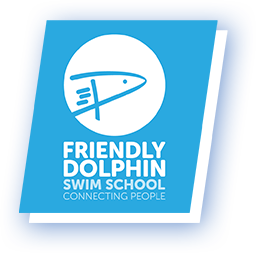Learn 4 Different Swimming Strokes And Their Benefits
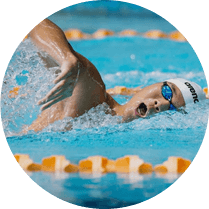
There are 4 kinds of different swimming strokes. Learning these 4 strokes usually comes after students have mastered the basic skills of swimming such as flotation, water buoyancy and water sculling.
Types of swimming stoke one – Freestyle Swimming or Front Crawl
Also known as the Australian crawl or American crawl is a swimming stroke usually regarded as the fastest of the four front primary strokes.
Front crawl starts from a streamlined position with your hands moving forward acting like a paddle to pull your body forward and your legs kicking up and down simultaneously to maintain the body in the streamline position.
The breathing for front crawl is done on the sideways every second pull by tilting your head slightly above the water as the picture illustrated below.
Freestyle is one of the most common strokes used for swimming competition, defined by the rules of the International Swimming Federation (FINA). Freestyle races are the most common of all the swimming competitions thus far.
There are long and short distances race for freestyle over a spectrum ranging from 50ms (50 yards) and reaching 1500 meters.
Freestyle or Front crawl is most commonly chosen by swimmers as this stroke usually provides a massive efficiency and less energy consumption for execution.
Learning Front Crawl Step by Step:
Here is a step by step to help you better understand and practice the right kind of techniques the next time in water for better learning.
- Float on your front with your face in the water horizontally, stretching your body as long as possible.
- Keep your legs long with toes pointed. Kick your legs up and down (alternating) making your ankles as floppy as possible, using your feet like flippers.
- Kick your legs fast and continuously without using much energy.
- The very purpose of this action is to keep your body streamline in the water so you can swim with less effort and swim more efficiently. Streamline position will help to reduce form drag, friction drag, and wave drag.
- Start with your arms stretched out long in front of your head. Pull one arm under your body all the way to the thigh. Bring your arm out of the water and sweep it over the water stretching it ready to enter the water in front of your head.
- Keep pulling your arms in a continuous movement so that as one arm enters, the other is ready to exit at the thigh. The fingers when performing the paddle action inside the water should be closely clenched so as to increase the efficiency of the strokes.
- Your head should also try to maintain 45 degrees look when it’s inside the water. You can do this by aligning your hairline to the surface of the water, do not dip the whole head inside as this will increase drag and causes more energy needed to execute a good front crawl.
- Turn your head to the side to breathe in. Turn as one arm is stretched in front and one at the thigh. Try to keep one ear in the water as you turn your head. As the arm sweeps over the water return your face back into the water and exhale out.
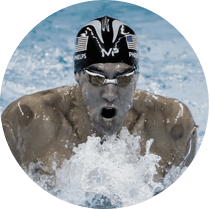
Types of swimming stroke two – Breaststroke
- Float on your front with your face in the water, stretching your body as long as possible. Keep your hands together.
- Keep your legs long and stretch your toes. Bend your knees slowly and bring your feet towards your bottom. Bend at the ankles to point your feet outwards then kick back and slightly downwards and snap your feet together.
- Keep your head in the water and stretch your arms out in front. Turn your hands so that the thumbs point down with both hands pressing out and round. Turn your hands so the thumbs point up and draw the hands together in a small circular action in front of the shoulders.
- Lift your head to breathe in as the arms start to come together (make a heart shape in the water), stretch your arms out and return your head to the water to breathe out. Breathe every stroke: “Pull, Breathe, Kick, Glide”.
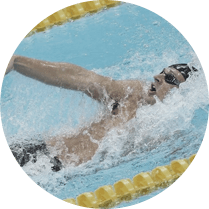
Types of swimming stroke three – Backstroke
- Float on your back, with your ears just in the water and eyes looking up; stretch your body as long as possible.
- Keep your legs long with pointed toes; kick your legs up and down (alternating) making your ankles as floppy as possible, using your feet like flippers. Your body should move sideways with your shoulders controlling the motion to make it feel like sampan. Knees should be kept under the water with your toes making a small splash. Kick your legs fast and continuously.
- The motion for this stroke should be kick, turn your shoulder for the purpose of making the body to tilt and create boat effects on the water, hand up moving like an arc and catch the water and push your hand back to align with the thigh position. Followed by the next hand with the same motion and repeat.
- Start with your arms stretched down the side of your body. Your arm should be kept straight bringing it out of the water over the top in an arc action. Enter your hands into the water with your little fingers first, keeping your arm straight. Pull your arm under the water all the way to the thigh. Keep pulling your arms in a continuous movement as one arm enters, the other is ready to exit at the thigh.
- A breath is taken regularly as and when required and at least once during the stroke.
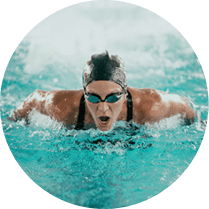
Types of swimming stroke four- Butterfly Stroke
- Float on your front with your face in the water, stretching your body as long as possible.
- Undulate your body from head to toes, in a whipping motion, bending and straightening your knees. Keeping your legs and feet close together, push down on the water with the top of your feet. And keep your feet just under the surface of the water.
- Enter both hands in the water at the same time, in line with your shoulders. Pull your arms under the body through to your hips. Recover your arms over the water surface ready to begin again.
- Push your chin forward to take a breath; the breath should be taken towards the end of the pull. As your arm sweeps over the water return your face back into the water and breathe out. Perform two kicks to each arm cycle, kicking at the start of the arm pull. And towards the end of the pull “Kick your arms in, kick your arms out”.
Swimming lessons are a fun addition to school curriculum
Kids put a lot of effort into school: Learning, focusing, appropriate behavior, etc. Having swimming lessons after school is a great way to release and get social – swimming lessons are unique and it keeps the learning going in a fun way while teaching kids a lifelong skill!
Start learning swimming at Friendly Dolphin Swim School, kids learn even more skills that are important in school as well. Like being patient, following instructions, comprehension, listening to teachers, and more!
Start investing in yourself from today. Learn more about swimming, do yourself a favor that will pay your more with interest in the future.
Knowledge and skills learned will help them to earn more in future
- Lifeguard earn a typical SGD$8- SGD$15/hour
- Swimming Instructor earn average SGD$30-SGD$50/hour
- Learning to swim add more leisure choices that save you more money.
- Give you the opportunity to do boating, kayaking, canoeing, sailing, surfing and go to the beach.
